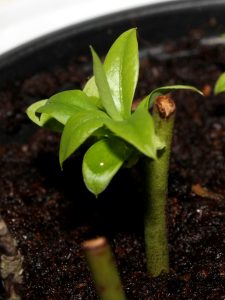Propagation of Blueberries by cuttings
Blueberry propagation is relatively easy and gives good results, but it takes at least a year to get a well rooted plant that can be planted to it’s final location.

Blueberries are usually propagated from softwood or hardwood cuttings by cutting twigs from healthy mother plants. Cuttings are then placed into soil, that holds moisture well and allows adequate aeration. Drainage is extremely important and in most cases cuttings fail to root, because of waterlogged soil which causes young fragile roots to rot. Softwood cuttings are usually taken during the late spring or early summer. Hardwood cuttings, on the other hand, can be obtained during winter dormancy in January or February in northern hemisphere.

Hardwood cuttings usually give better results than softwood cuttings, which are more delicate, can easily dessicate and are more susceptible to fungal infections and rot. To take hardwood cuttings, one year old shoots are used. It’s essential that the cuttings don’t have flower buds, if they do, you need to cut off the top part of the shoot. Flowers make rooting almost impossible, because they deplete the energy of the cutting faster than new roots can grow. Cuttings need to be 10 to 12 cm long. Bottom part of each cutting needs to be severed, to promote root growth. By peeling of 1 cm of bark on one side of the cutting should be enough. Place the cuttings into the soil so that the peeled bark ends up on the bottom in the substrate. You need to stick at least half of the cutting below soil level and only one or two leaf buds above the soil.

In a couple of months, cuttings form callus around the wounded tissue and it doesn’t take long before first roots appear and the cuttings take off. The roots are fragile in the beginning, so it’s essential to keep the rooting medium moist but not overly wet. It is essential to keep the cuttings protected from drying out at this phase. If everything goes well, first cuttings start swelling the buds on the shoots they initially grew in the beginning. The new growth indicates that the cuttings made their first roots. Those roots make it possible for them to acquire more nutrients and continue with growth. When their second growth phase is completed after the growth of new leaves and shoots ceases, it’s time to plant them into separate pots. Some of the cuttings never make it and I wouldn’t wait too long, before I transplant the ones that had rooted successfully.

